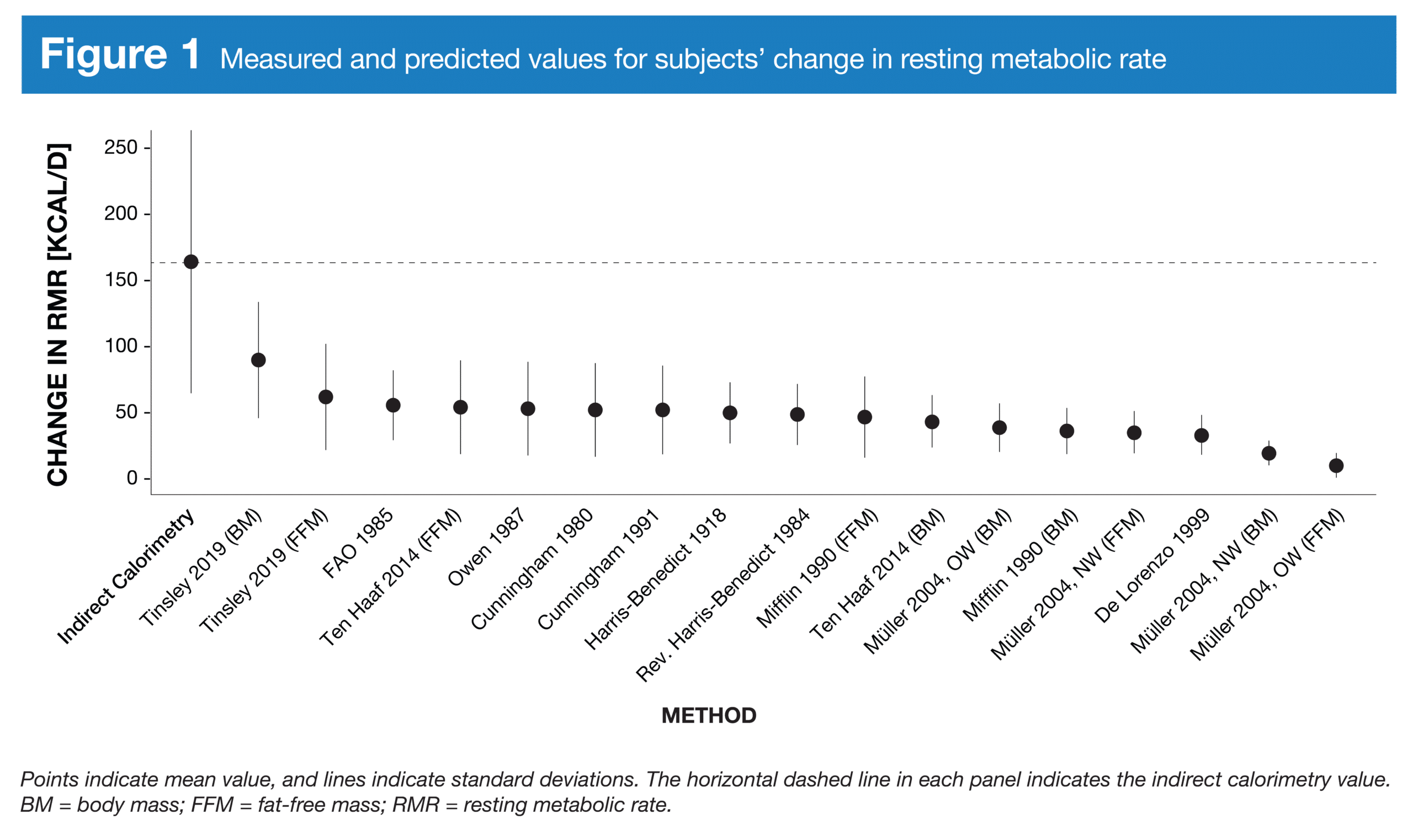In a recent MacroFactor article, Greg took a deep dive into “The Problems with Calorie Counting.” If you think he’s suggesting that the laws of thermodynamics have broken down and calorie counting doesn’t work, that’s not the case. Rather, his article discusses some common pitfalls that prevent dieters from reaching their goals, even when they’re earnestly trying to track their calorie intake accurately. One of the common sources of error he addresses is using a calorie calculator to set daily calorie intake targets. There are many such calculators online, and they all rely on previously validated equations to predict an individual’s resting metabolic rate based on basic information, such as age, sex, weight, and body fat percentage. In many cases, this will be coupled with a generic physical activity correction factor, which allows the calculator to estimate total daily energy expenditure rather than focusing on resting metabolic rate alone.
That sounds nice, but there’s a problem. Fat-free mass is the most reliable predictor of energy expenditure (2), but as Dr. Helms covered in a previous MASS article, total daily energy expenditure varies quite a bit, even for people with the same exact amount of fat-free mass. In Greg’s previously mentioned article, he ran through a very detailed and extensive example from start to finish. Based on past research, Greg simulated a data set of resting metabolic rate values for 3,000 “subjects” with a mean of 1564 kcal/day, with a standard deviation of 336 kcal/day. These represent “true” resting metabolic rates. He then mathematically accounted for the typical error, yielding a sample of “estimated” resting metabolic rates with a typical magnitude of estimation error. After that, he applied physical activity correction factors to both samples of data, leaving him with 3,000 “true” values for total daily energy expenditure, and 3,000 “estimated” values. Following this process, less than half of the estimated values were within 250kcal/day of the true values.
If you’re starting to question the utility of these calculators, it gets worse. So far, we’ve discussed the best case scenario: a weight-stable person at their typical body weight. As we’ve discussed many times in MASS, metabolic adaptation occurs with weight loss. As a result, people experience reductions in total daily energy expenditure, and the magnitude can be quite variable from person-to-person and very difficult to predict. The inverse is true for bulking; during intentional weight gain, it’s common to see fairly large increases in both resting and total daily energy expenditure, but the exact magnitude will vary from person-to-person and be difficult to predict. So, how effectively do some of these common resting metabolic rate equations account for increases that are observed during bulking?
That’s exactly what the presently reviewed study by Rodriguez et al investigated (1). The researchers’ stated purpose was “to evaluate the validity of several commonly used prediction equations to track [resting metabolic rate] changes during a hypercaloric nutritional intervention and supervised resistance exercise training program.” To accomplish this goal, they had 20 resistance-trained males complete a 6-week resistance training program while simultaneously consuming a hypercaloric diet. In order to participate, subjects needed to bench at least 100% of their body weight and leg press at least 200% of their body weight. Participants were 21.9 ± 2.6 years old, 178.1 ± 6.9 cm tall, and weighed 72.2 ± 7.3 kg. At baseline, the average body-fat percentage was 17.5 ± 4.5%, with a fat-free mass index of 18.9 ± 1.5 kg/m2, and a resting metabolic rate of 1,712 ± 166 kcal/day.
Supervised resistance training sessions were performed three days per week, and participants were encouraged to gain at least 0.45kg/week. Participants were weighed before each training session to encourage compliance and keep them on track with their intended weight gain goal. Before and after the intervention, body composition was measured via DXA, and resting metabolic rate was measured via indirect calorimetry. Average energy intake during the intervention was 3855 ± 1365 kcal/day, and participants consumed 169 ± 52 grams of protein, 462 ± 157 grams of carbohydrate, and 138 ± 59 grams of fat per day. Scaled to body mass, this protein intake was equivalent to 2.3g/kg, on average. Based on changes in stored body tissue, the estimated caloric surplus during the intervention was 377 ± 303 kcal/day.
As one would expect, participants gained weight during the bulking intervention. Total weight increased by 3.6 ± 1.7 kg, with about two thirds of that being fat-free mass. Measured resting metabolic rate also increased, by a magnitude of 165 ± 97 kcal/day. So, how’d the various resting metabolic rate equations do when trying to estimate this increase? As shown in Figure 1, not very well. All of the equations underestimated the change, and none got within 100kcal/day of the measured value. Two of the predictive equations nearly missed the increase entirely, with predicted increases of <20kcal/day beyond baseline. Overall, the equations that overestimated at baseline (neutral weight, neutral energy balance) did a decent job estimating resting metabolic rate after the intervention, the equations that were pretty close at baseline did a poor job after the intervention, and the equations that underestimated at baseline did a terrible job after the intervention. If you’re thinking, “hey, 100-150kcal/day of error isn’t that bad,” remember that this pertains to resting metabolic rate only. When you try to convert this to total energy expenditure (for the purpose of identifying a calorie intake target), the error tends to grow even more.

Even if an equation does a pretty good job estimating your resting metabolic rate at baseline (neutral weight and neutral energy balance), it may perform considerably worse when you start losing or gaining weight. So, how are we supposed to find a decent calorie target when bulking or cutting?
As I describe in a Stronger By Science article from last year, your best bet is to lean on empirical, individualized observations. All you need to do is accurately track your body weight every morning and your daily energy intake, and you can identify the calorie target required to meet your weight loss, weight gain, or weight maintenance goal. For example, if you’re trying to maintain body weight, then you’re trying to find the calorie target that keeps your weight stable. If body weight starts dropping, you bump calories up. If body weight starts creeping upward, you drop calories. Through this iterative process, you titrate your caloric intake to match your weight maintenance target, or your target rate of weight gain or loss.
If you typically track your weight and calorie intake, you might know exactly where to start with your calorie intake when you begin working toward a new weight loss or weight gain goal. If not, a predictive equation (like one of the equations used in the presently reviewed study) might actually be useful, as a temporary crutch. Personally, I like to use the 1980 version of the Cunningham equation (3), as it tends to do well for body types ranging from the general population to muscular physique athletes (4). From there, I recommend using the MacroFactor physical activity correction factors to convert resting energy expenditure to total daily energy expenditure – not because they’re based on state-of-the-art, cutting-edge mathematical wizardry, but because they simply make way more sense than the standard sets of correction factors.
Is this a perfect starting point? Unfortunately not – there is no perfect starting point that comes from a generic estimation equation, as resting metabolic rate varies too much among individuals with the same exact body size and body composition. It is merely the best available estimate when recent weight and energy intake data are unavailable. Will this equation-based approach accurately navigate changes in energy expenditure as you lose or gain weight? Probably not, as the presently reviewed study indicates. The purpose of this equation-based approach is merely to identify your starting point for caloric intake, and it’s specifically reserved for circumstances in which you’d otherwise have no idea where to start. The moment you set your starting point, you switch over to the iterative, observational approach I described previously. You accurately track your body weight every morning and your daily energy intake, and you can identify the calorie target required to meet your weight loss, weight gain, or weight maintenance goal.
So, these predictive equations for resting metabolic rate aren’t totally useless, but their utility is very limited. They’re sometimes the best available method for identifying a starting point for your calorie intake target, but once weight changes start occurring, an empirically-driven approach is the best path forward. Simply put, it’s the best way to get a truly individualized calorie target that can be appropriately adjusted when you experience increases in energy expenditure while bulking and decreases in energy expenditure while cutting.
Note: This article was published in partnership with MASS Research Review. Full versions of Research Spotlight breakdowns are originally published in MASS Research Review. Subscribe to MASS to get a monthly publication with breakdowns of recent exercise and nutrition studies.
References
- Rodriguez C, Harty PS, Stratton MT, Siedler MR, Smith RW, Johnson BA, et al. Comparison of Indirect Calorimetry and Common Prediction Equations for Evaluating Changes in Resting Metabolic Rate Induced by Resistance Training and a Hypercaloric Diet. J Strength Cond Res. 2022 Nov 1;36(11):3093–104.
- Pontzer H, Yamada Y, Sagayama H, Ainslie PN, Andersen LF, Anderson LJ, et al. Daily Energy Expenditure Through The Human Life Course. Science. 2021 Aug 13;373(6556):808–12.
- Cunningham JJ. A Reanalysis Of The Factors Influencing Basal Metabolic Rate In Normal Adults. Am J Clin Nutr. 1980 Nov;33(11):2372–4.
- Tinsley GM, Graybeal AJ, Moore ML. Resting Metabolic Rate In Muscular Physique Athletes: Validity Of Existing Methods And Development Of New Prediction Equations. Appl Physiol Nutr Metab. 2019 Apr;44(4):397–406.




